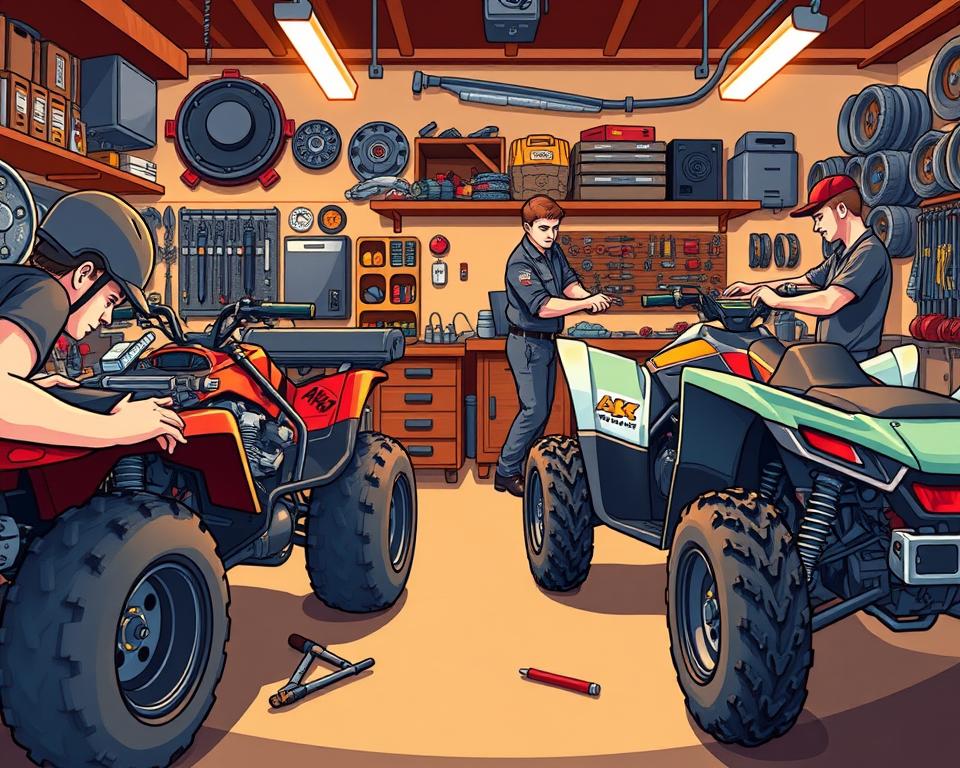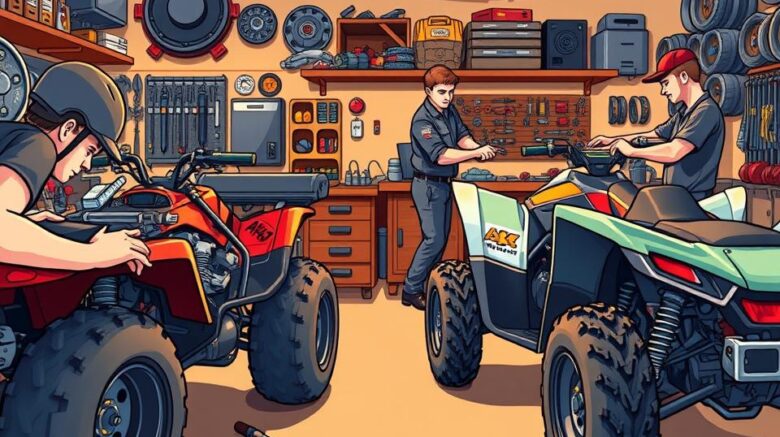Avoiding ATV/UTV Gearing Mistakes for Newbies
Did you realize that nearly 25% of new ATV and UTV owners face gear selection issues within their first year? Such data emphasizes how critical gear ratios are for novice riders. Correct gear choice protects against accidents as well as enhances power. We’ll explore common mistakes, maintenance practices, and expert rokblokz mudflaps advice to improve your off-road adventures.
Major Highlights

- Understanding gear ratios is vital for optimal ATV/UTV performance.
- Common gearing oversights can lead to safety risks on the trails.
- Scheduled upkeep stops gearbox failures.
- Proper gear selection greatly enhances off-road riding experiences.
- Implementing ATV maintenance tips can prolong vehicle lifespan.
Understanding ATV and UTV Gear Ratios
Ratios determine how engine output translates to drive force. They govern both top speed and hauling capacity. That impacts hill climbs and tow capabilities. Different gear ratios can transform a vehicle’s performance, making it better suited for racing, off-road driving, or towing.
Choosing the right UTV gear is key to understanding engine performance. A low gear ratio can hinder torque during steep climbs or when carrying heavy loads. Conversely, too high a ratio hampers quick takeoffs on flats.
Riders often tweak reduction ratios for trail versatility. Tuning ratios lets you fine-tune speed vs. torque. It lets you balance acceleration with pulling force. Optimal ratios deliver smoother use and better MPG.
Common Gearing Oversights for New ATV/UTV Owners
Choosing the right gear is key to optimal performance and safety when riding an ATV or UTV. First-timers frequently ignore ratio considerations. Understanding the effects of wrong gear choices and selecting the right one for your terrain can greatly improve your ride. And it sidesteps needless breakdowns.
Impact of Incorrect Gear Selection
Choosing the wrong gear can lead to serious problems, including loss of control and mechanical failures. The wrong gear can slow down acceleration, affect braking, and cause excessive wear. These mistakes can significantly reduce riding safety, posing risks to the rider, passengers, and others nearby. Adhering to service guidelines prevents such failures.
Choosing the Right Gear for Terrain
Different terrains need different gearing for efficient performance. To conquer grades, use lower speeds and higher torque. To cover ground quickly, shift to higher ratios. In muddy or sandy conditions, choosing the right gear is essential for traction and stability. Knowing these environmental factors is critical for safe and enjoyable off-road adventures.
The Importance of Proper ATV Maintenance
Scheduled service avoids surprises on the trail. Using upkeep best practices stops breakdowns and protects riders. A tailored service plan prioritizes drivetrain care.
Regular Inspection and Maintenance
A detailed inspection checklist is essential for spotting issues early. Regularly inspect the drive train, stopping systems, wheels, and belts. By making this checklist a part of your routine, you can greatly enhance your vehicle’s performance. Here are some critical inspection points to remember:
- Examine gear alignment and wear.
- Verify hardware and linkages are secure.
- Inspect brake lines and levels.
- Inspect tire pressure and tread depth.
- Inspect battery terminals and cables for buildup.
Fluid Changes and Gear Health
Fluid quality is critical for UTV drivetrain maintenance. Regularly changing engine oil, gear oil, and coolant prevents grime buildup. Fresh oil cuts wear and heat for lasting components. By following these practices, you can maintain your gear in top condition, ensuring reliable performance on every ride.
| Fluid Type | Recommended Change Interval | Benefits of Regular Change |
|---|---|---|
| Motor Oil | 50–100 operating hours | Reduces engine wear, enhances performance |
| Gear Oil | Every 100-200 hours | Smooths shifts and prevents pitting |
| Coolant | Once per year | Stops boil-overs and freezes |
Adhering to this schedule grants worry-free adventures. That boosts confidence and enjoyment.
Common ATV Gear Shifting Problems
Many beginners wrestle with the gearbox. Developing fluid shift skills elevates trail enjoyment. It reduces frustration on the trails. Timing throttle and clutch releases prevents gears from crunching.
Learning to Shift Smoothly
Honing silky shift skills takes deliberate training. Begin by listening to your motor’s cadence. Smooth gear engagement reduces transmission stress and prevents issues. Blending throttle with clutch release ensures seamless shifts.
Drill shifts in an open space to build skill. Focus on gentle throttle application during each gear change.
Recognizing Signs of Gear Issues
Early detection of gear issues is essential. Be alert for clicks, clunks, or grinds when shifting. Stuck gears or false neutrals are warning signs. Fixing problems fast keeps you safer on the trail. Addressing ATV gear shifting problems properly maintains vehicle performance and boosts your confidence while riding.
Understanding UTV Transmission Issues
UTV gearbox troubles challenge many owners, so familiarity helps diagnose. Typical troubles involve gears that slip and grinding sounds. Here we examine usual faults and outline a step-by-step fix plan. Leveraging user-friendly diagnostic procedures.
Diagnosing Common Problems
Recognizing the signs of transmission troubles is essential. Common issues include:
- Gears that pop out under load, risking accidents.
- Strange noises signaling internal wear.
- Leaking transmission fluid, potentially leading to more severe problems.
Regular gear diagnostics help spot these issues quickly. It lets you fix faults before they worsen. Overlooking warnings costs more in the long run.
Solutions for Troubleshooting UTV Transmissions
Solving drivetrain faults depends on a structured routine. Follow these steps for effective troubleshooting:
- Ensure gearbox fluid is at spec, then add if low.
- Inspect pan and seals for drips.
- Open housing to check bearings and gears.
- Test drive the UTV at various speeds to monitor gear engagement and responsiveness.
- Reference factory troubleshooting charts for your UTV.
Leveraging a proven guide speeds up repairs. Understanding gear mechanics is key for any UTV owner. It greatly enhances your vehicle’s longevity and efficiency.
ATV Clutch Adjustments and Their Benefits
Proper ATV clutch adjustments are key to a great riding experience. Bad clutch setup leads to gear grind and confusion. Routine calibration refines clutch response and engagement.
Precision in gear changes is critical. An optimally adjusted clutch ensures quick and smooth gear changes. That boosts throttle response and enjoyment in every gear.
Skipping clutch care leads to early failures and poor shifts. Consistent adjustments sustain peak clutch function. It’s critical for both new and seasoned riders to ensure their ATV performs at its best.
Mastering the Art of Gear Shifting
Mastering gear shifting techniques greatly enhances your riding experience. It requires knowledge of your vehicle’s mechanics and developing a keen sense of timing and spatial awareness. Beginners should focus on the rhythm of shifting gears. A steady shift rhythm yields cleaner transitions and more power.
Smooth shifts arise from varied-condition training. Recognizing terrain-specific shift cues boosts confidence and protection. Dropping a gear before a climb preserves torque and control.
- Rehearse clicks slowly to gain control.
- Observe how your vehicle responds to different shifts.
- Gradually incorporate more challenging terrains to test your skills.
Tuning into your ATV’s feedback is key to shift mastery. Pay attention to engine sounds and vibrations. These cues pinpoint exact shift timing. This natural touch produces fluid gear changes for maximum enjoyment.
Best Practices for UTV Gear Selector Problems
Managing UTV gear selector problems demands a proactive maintenance and diagnostic approach. Frequent selector checks prevent surprises. By mastering gear selection techniques, operators can avoid malfunctions. Routine checks should include visual inspections of the selector linkage and fluid levels, which are vital for performance.
At the first sign of trouble, clear debris from the shifter. Unusual noises can also hint at problems. Minor tweaks typically fix selector snags. A routine plan stops small faults from growing.
Tracking shift quality across terrains isolates faults. Applying these tips secures selector durability and trail confidence.
Tips for Enhancing Gear Performance
Sustaining peak gear health involves systematic care. Scheduled upkeep enhances ATV efficiency. Monitor fluids, look for damage, and fine-tune as required. Catching nicks before they worsen saves you big bucks.
Picking ideal ratios unlocks quicker revs and seamless cruisin’. Assessing ground conditions guides your ratio picks. It shapes your bike’s quickness and runway performance. Partnering with trusted makers like American Off-Roads for UTV performance enhancements adds power and reliability.
Implementing gear performance tips in wheels, springs, and ballast optimization elevates function. Those mods lead to stable, confident rides across tough terrain. This leads to a more enjoyable riding experience. These steps ensure fearless exploration and maximum excitement on the trail.
Final Thoughts
Nailing gear selection unlocks peak power and protection. Matching gears to ground types transforms your adventure. Steering clear of rookie errors and picking wisely ensures safe, thrilling rides.
No less crucial is keeping your drivetrain in top trim. Scheduled maintenance and TLC save you from breakdowns and prolong service. Adequate maintenance enhances function and safeguards adventures across any terrain.
Combining correct gearing with scheduled service delivers peak satisfaction for riders. Adopting these practices ensures many memorable rides and adventures in the future.
FAQ
What are the typical gear ratios for ATVs and UTVs?
Ratio specs differ greatly by manufacturer and use case. They usually range from 3:1 to 5:1. Low-end ratios yield higher pulling power. Higher ratios, on the other hand, can increase top speed on flat terrain.
How can I determine if I’m using the wrong gear for my terrain?
Using the wrong gear can lead to loss of control, excessive engine revving, or poor acceleration. Each terrain type—mud, sand, rock, or snow—requires specific gear selection for optimal performance.
How to know when your machine needs service?
Head off issues if shifts go crunchy, the box hums, oil drips, or power falls off. Scheduling drivetrain inspections stops big failures.
How often should I change the fluids in my ATV/UTV gear system?
Aim for a fluid swap between 1,500–2,500 miles or annually, whichever comes first. Pure oils maintain smooth shifts and protect internals over time.
Best practices for flawless shifts?
Sync your revs and clutch for seamless gear changes. Feather the clutch up while winding the throttle for a perfect match.
Steps to diagnose gearbox problems?
Start by checking for common problems like slipping gears or strange noises. Verify oil clarity and fill. Next, test-drive at varied speeds to see how it shifts.
What is the importance of clutch adjustments in an ATV?
Proper clutch adjustments are essential for smooth gear transitions. Bad clutch alignment wears out parts prematurely and hinders shifts.
Adapt gearing for every surface?
Test multiple gearing options and look into quality mods by American Off-Roads. Regular maintenance, such as checking gear health and fluid levels, also enhances performance.
When your UTV shifter sticks?
Regular inspections and routine maintenance are key. If you encounter issues with a stuck selector or improper gear engagement, consult the troubleshooting guide in your owner’s manual for step-by-step diagnostics.
What common mistakes should new ATV/UTV owners avoid?
Rookies tend to ignore ratio basics, delay upkeep, or misgear for mud, rock, or hills. These mistakes hamper performance and raise the chance of mishaps.
